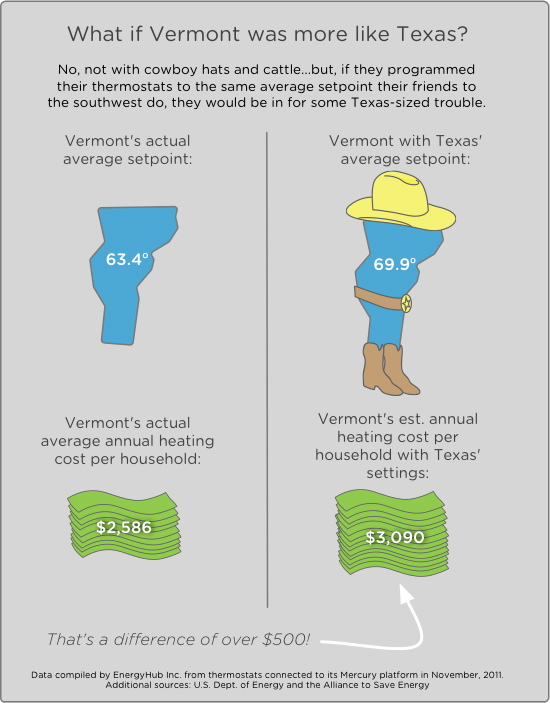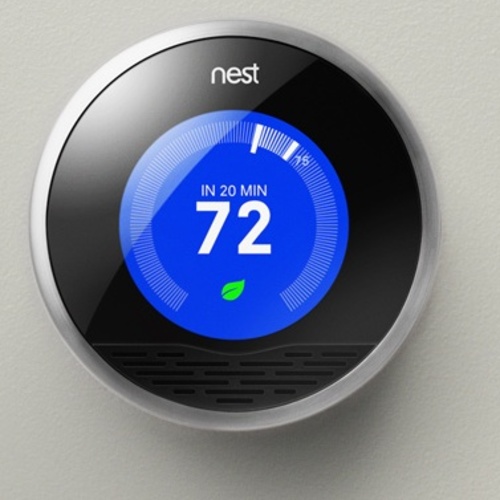
When it comes to creating wintertime comfort with a thermostat, the calculations would seem to be pretty straightforward: factor in the building occupants’ notion of comfort and what they’re willing to pay to heat the building interior to satisfy those notions, then set the thermostat accordingly and be done with it.
Simple. But it turns out that process tells us some things about occupant behavior that really aren’t so straightforward. Utility usage data collected and analyzed by EnergyHub, a Brooklyn, New York-based specialist in energy conservation tools and strategies for homeowners, showed that the correlation between occupants’ geographic location and their average wintertime thermostat settings didn’t match expectations. Residents in northern states, it turns out, tend to set their thermostats lower in the winter than residents in southern states, despite the usual differences between the two regions in average outdoor temperatures.
The analysis revealed, for example, that residents in Vermont, which has an average of 7,746 heating degree days a year, set their thermostats at 63.4 degrees, while residents in Texas, which has 1,862 heating degree days a year, set their thermostats at 69.9 degrees. (EnergyHub collected the data from its smart thermostat software platform, Mercury, which is designed to allow residents to control interior temperatures while factoring in a range of energy-saving strategies, including daytime and nighttime temperature preferences as well as costs per degree.)
A tolerance for cold?
EnergyHub suggests that people who live in cold-climate states tolerate lower ambient indoor temperatures because they’ve adapted to the cold. Or, as one recent Greentech Media post noted, they are simply accustomed to wearing sweaters and other layers of clothing during the winter months.
Very likely, too, cold-climate residents, many of whom rely on oil heat (while Texans rely on gas, which is less expensive), are mindful of the high cost of setting the thermostat much above 65 degrees.
There may be other issues at play here as well. One commenter to the Greentech Media item noted that many dwellings in both Vermont and Maine are owned by vacationers who have equipped their homes with remotely controlled thermostats that they set at 50 degrees in wintertime, when the buildings are usually unoccupied.
GBA editor Martin Holladay offered another theory. Many Vermont homes have wood stoves in addition to central heating. Even when a thermostat is set at 60 degrees, he points out, a wood stove can still warm a house to 72 degrees.
Weekly Newsletter
Get building science and energy efficiency advice, plus special offers, in your inbox.












11 Comments
Have thermostat settings changed over the years?
The current high cost of fossil fuels may drive consumers to lower thermostat settings to economize. In our household we prefer 70F daytime settings and a 62F nightly setback, we have decreased heating energy consumption by nearly 1/2 since moving in. Increased comfort for the occupants should be the headline for residential energy retrofit companies. The payback for energy retrofits where heating oil and propane is the normal fuel should be quite short.
Thermostat setback savings
Richard,
I do not doubt your math but I think the energy savings for thermostat setback is often misunderstood and often overestimated. The chart you show is by others, how does an approximate 10% reduction in the delta T for an average winter day in Vermont result in a 20% energy savings?
Meanwhile in Texas...
They also set thermostats to 63°F in the summer. It's part of how Texans like to show Nature who's the boss.
oversimplified?
When I moved from the Berkshires (MA) in 2006 to the Atlanta (GA) area, one of the first things I noticed was that 40-45 degrees here felt as cool as ten degrees less did up Nawth. I hadn't had time for metabolism to reset my body temp. Lots of other northern transplants comment on the same thing.
In my case I think that humidity plays a role, and the kind of heat as well. Up there I used wood (by convection) with a temp diff exterior to interior of about 40-50 degrees. I recall in interior rel.humidity in my house being 25% or so and exterior normally around 50-60%.
In GA I have a heat pump, a temp difference normally of 25, and interior humidity at this moment at 42%. Outside humidity is 98%.
The role of humidity really ramps up when it's air conditioning season. The temperature can be ever so comfortable sounding (80 e.g.) but the humidity is still up in the 90s, often for the entire day, so air conditioning runs continually.
If there was some low-energy solution that would dehumidify interior air, I could get by with a fraction of the heat, and A/C, that I use.
Like Gma used to say "It ain't the heat, it's the humidity."
Except, of course, if I lived in Houston it would be both!
Perfect!!!
This is a great example why one size does not fits all. That's why EE means different things around the country. That's why house footage, carbon footprint and rules are relative to geography, occupants and their behavior, and energy use.
Ok, but ... 63F? Really?
63F is darned chilly. And even if that's an average over the day, that's one heck of a setback. We have cold winters here too, and I'm an energy miser by and large, but my family would revolt if the thermostat averaged 63F. I'd like to see more data behind this; something just seems off kilter.
If Martin is right, and the wood stoves make up the difference, the thermostats would know that too - is the home's temp rising significantly above the setpoint?
Duh!
No surprises here: northerners wear more clothes, outside the house of course but indoors too. The winter I spent in Minnesota taught me never to never to go out without long thermal underwear, thick socks, warm shirt, insulated vest, parka etc. There's a practical limit to how many of those layers you want to take off when you get home. Here in the south we wear far fewer layers outside, and consequently indoors as well.
And your point is??
This seems entirely intuitive: Martin, James, and the others have it about right. I doubt that Texans and Georgians routinely wear thermal underwear, sweaters, wool socks around the house, or build the fire up to take off a chill.
In southern New England, my thermostat is in the 50's during off-hours, in the mid-60's for wake-up and evening. And if it feels a bit chilly, I don't feel in the least guilty cranking it up to 68 or 69, knowing that the automatic thermostat will return it to "normal" at the next click in the cycle.
more information about Mercury monitoring pls
Richard, I agree with Eric, and suspect Martin may be right about other heat sources. Did the Mercury system monitor or the indoor temp or just the setpoint? Also, given that the Mercury platform supported setback, was the 63.4F the average for nighttime setting, or a time-weighted average?
Vermont indoor temperatures
I found the 63 degree number a bit surprising, but when I lived in an oil- and wood-heated house in Vermont in the 80s, I actually think we probably were close to that.
Leaving aside where the thermostat was actually set, the rooms in our house that weren't directly connected to the wood stove room ran high 60s in late afternoon and down to high 40s at night. There's a house where setback would change your delta-T pretty good, it would easily drop 20 degrees on a cold night.
The room with the stove was pretty nice more of the day, it would heat up quickly and stay probably well above 70.
Oh, and the thermostat was usually set to 50 except if we were feeling lazy about waiting for the stove.
Michael Blasnik's take
At the NESEA conference in Boston, I just spoke to Michael Blasnik about this finding. Blasnik has recently reviewed gigabytes of data from the new NEST thermostats -- data that includes indoor temperatures as well as thermostat settings.
He says the finding that Vermonters set their thermostats lower in winter than Texans is true, and that wood stoves have nothing to do with it. He says that Vermonters are just frugal and used to the cold, and they turn down their thermostats at night and when they leave their homes.
"There is a very strong correlation between winter thermostat set points and voting for McCain in the 2008 election," Blasnik said. "In states with a high proportion of McCain voters, winter thermostats are set higher than in states that voted for Obama."
Log in or create an account to post a comment.
Sign up Log in